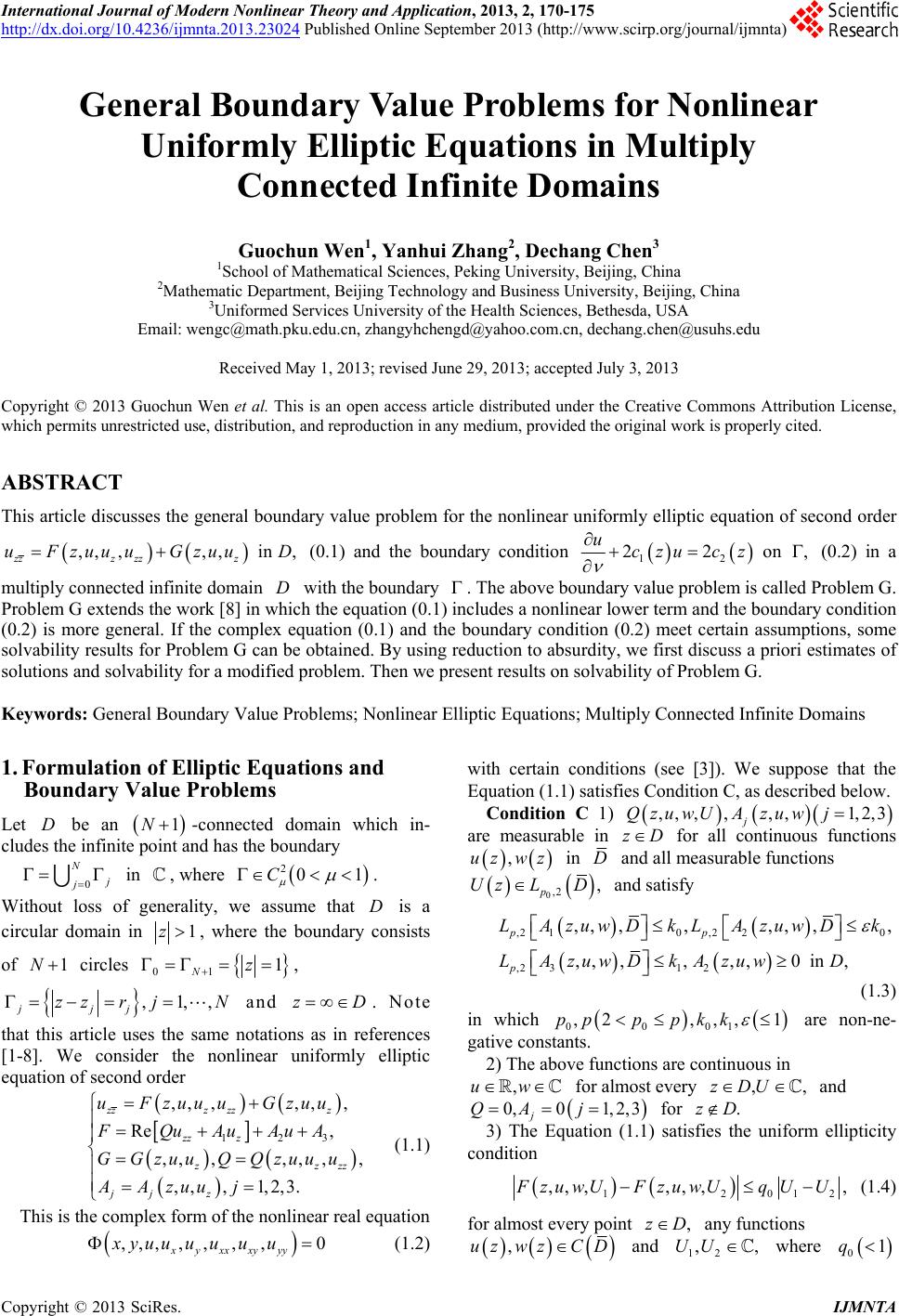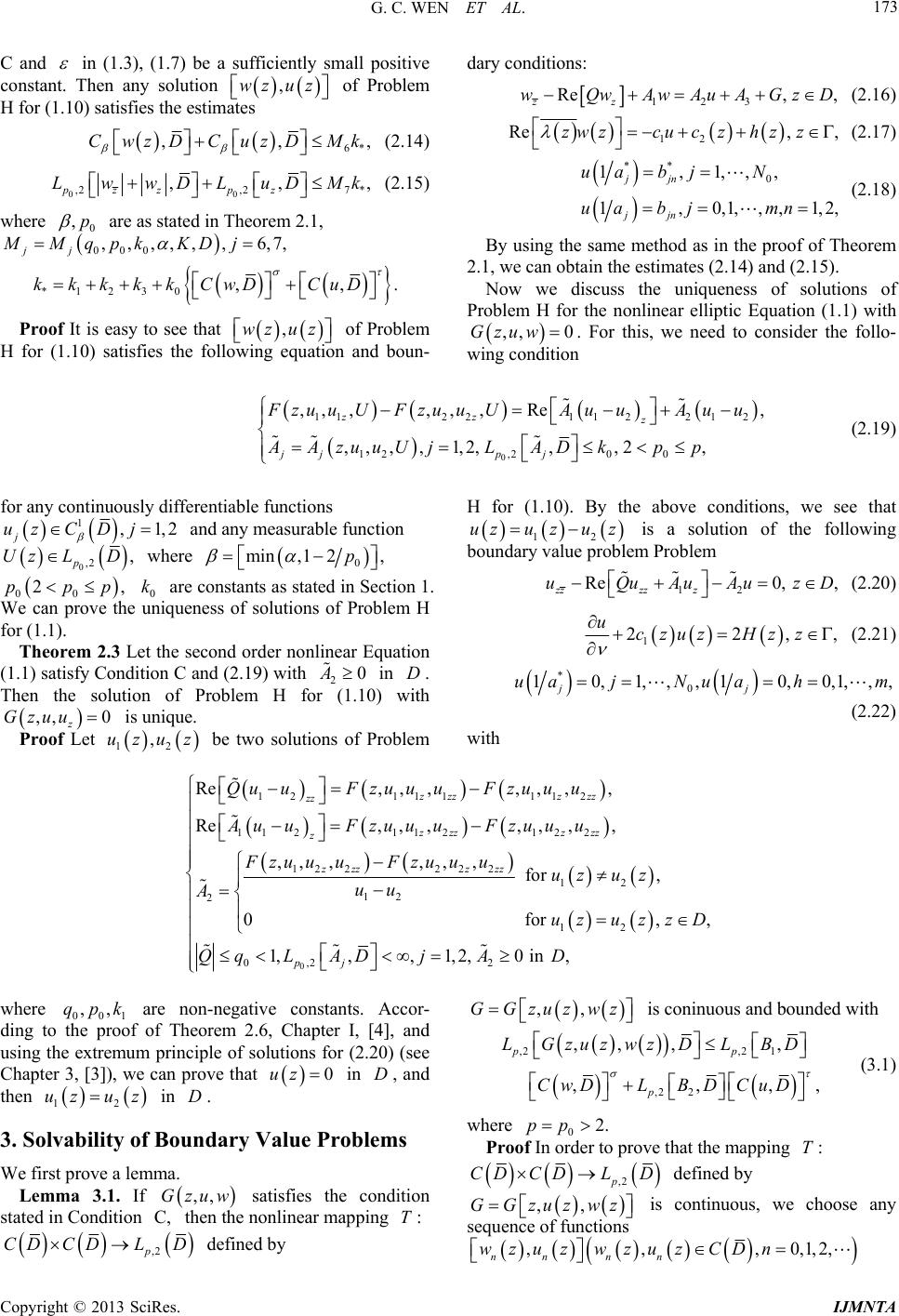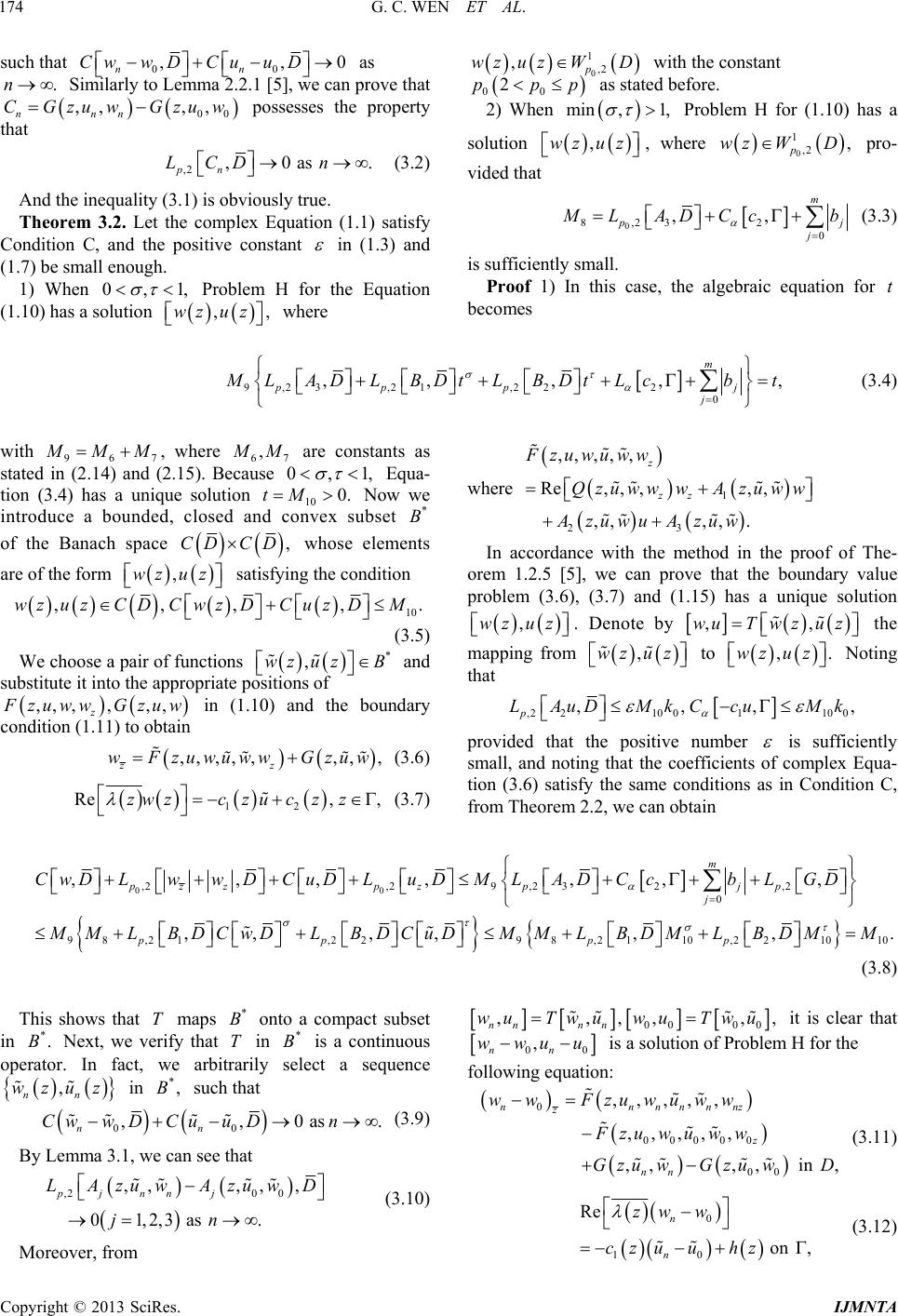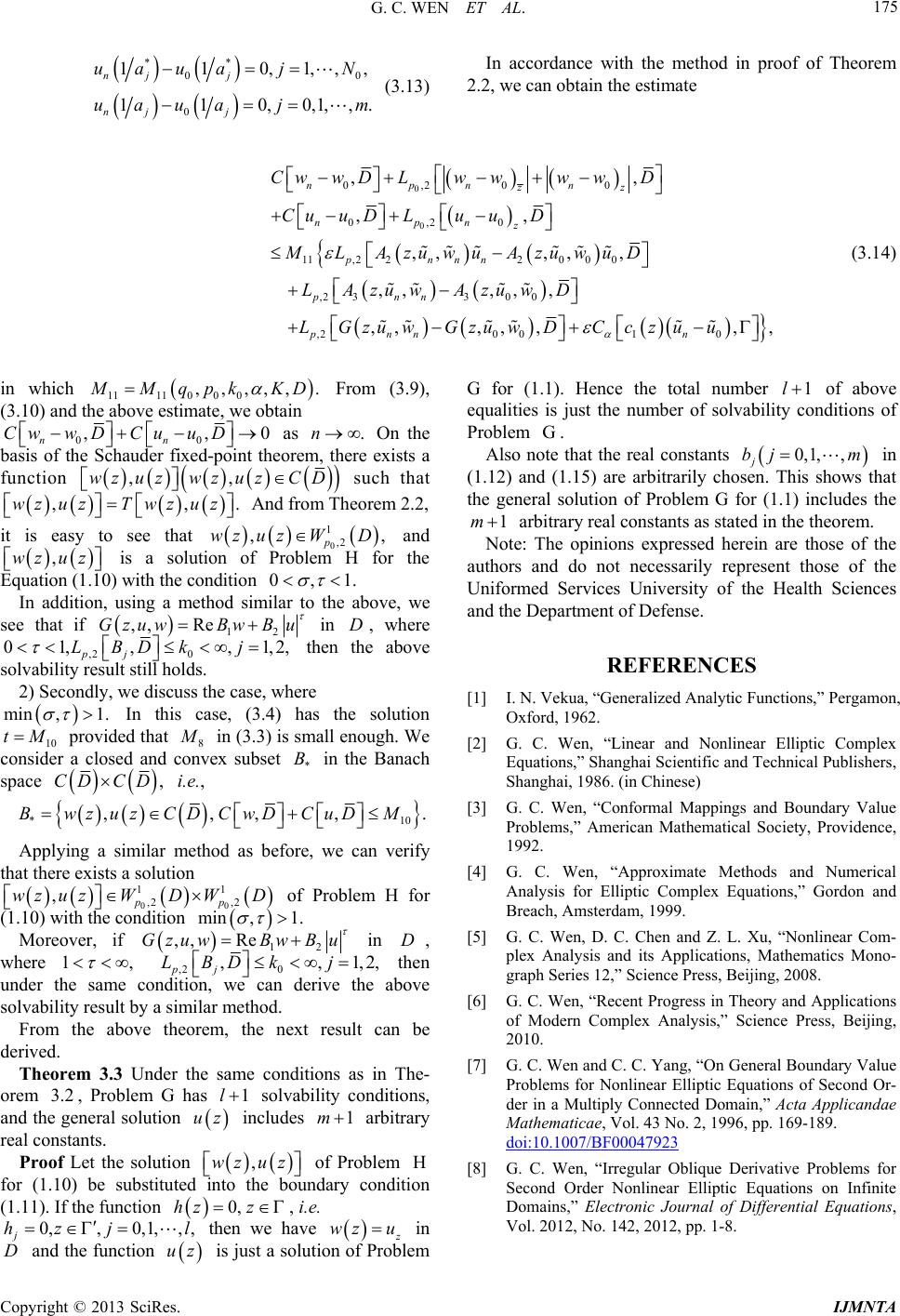 International Journal of Modern Nonlinear Theory and Application, 2013, 2, 170-175 http://dx.doi.org/10.4236/ijmnta.2013.23024 Published Online September 2013 (http://www.scirp.org/journal/ijmnta) General Boundary Value Problems for Nonlinear Uniformly Elliptic Equations in Multiply Connected Infinite Domains Guochun Wen1, Yanhui Zhang2, Dechang Chen3 1School of Mathematical Sciences, Peking University, Beijing, China 2Mathematic Department, Beijing Technology and Business University, Beijing, China 3Uniformed Services University of the Health Sciences, Bethesda, USA Email: wengc@math.pku.edu.cn, zhangyhchengd@yahoo.com.cn, dechang.chen@usuhs.edu Received May 1, 2013; revised June 29, 2013; accepted July 3, 2013 Copyright © 2013 Guochun Wen et al. This is an open access article distributed under the Creative Commons Attribution License, which permits unrestricted use, distribution, and reproduction in any medium, provided the original work is properly cited. ABSTRACT This article discusses the g eneral boundary value problem for the nonlinear uniformly elliptic equation of second order ,, ,,,in, zzz zzz uFzuuuGzuu D (0.1) and the boundary condition 12 22on uczu cz , (0.2) in a multiply connected infinite domain with the boundary D . The above boundary value problem is called Problem G. Problem G extends the work [8] in which the equation (0.1) includes a nonlinear lower term and the boundary condition (0.2) is more general. If the complex equation (0.1) and the boundary condition (0.2) meet certain assumptions, some solvability results fo r Problem G can be obtained. By using reduction to absurdity, we first d iscuss a priori estimates of solutions and solvability for a modified problem. Then we present results on solvability of Problem G. Keywords: General Boundary Value Problems; Nonlinear Elliptic Equations; Multiply Co nnected Infinite Domains 1. Formulation of Elliptic Equations and Boundary Value Problems Let be an -connected domain which in- cludes the infinite point and has the boundary D 1N 0 N j in , where 201C . Without loss of generality, we assume that D is a circular domain in 1z, where the boundary consists of circles 1N 01 1 Nz , ,1,, jjj zzr jN and . Note zD that this article uses the same notations as in references [1-8]. We consider the nonlinear uniformly elliptic equation of second order 123 ,, ,,,, Re , ,,,,, ,, ,, ,1,2,3. zzz zzz zz z zz jj z uFzuuuGzuu FQuAuAuA GGzuuQQzuuu AAzuuj zz (1.1) This is the complex form of the nonlinear real equation ,,,,,,,0 x y xx xyyy xyuu u uuu (1.2) with certain conditions (see [3]). We suppose that the Equation (1.1) satisfies Condition C, as described below. Condition C 1) ,,, ,,,1,2,3 j QzuwUAzuwj zD are measurable in for all continuous functions ,uz wz in D and all measurable functions 0,2 , p Uz LD and satisfy ,2 10,220 ,231 2 ,, ,,,, ,, ,,,,,,0in, pp p LAzuwDkLAzuwD k LAzuwDkAzuw D (1.3) in which 0001 ,2,,,1ppppkk are non-ne- gative constants. 2) The above functions are continuous in ,uw , for almost every and ,zDU 1,2,3j0, 0 j QA for .zD 3) The Equation (1.1) satisfies the uniform ellipticity condition 1201 ,,, ,,,, 2 zuwUF zuwUq UU (1.4) for almost every point ,zD any functions ,uz wzCD and where 12 ,,UU 01q C opyright © 2013 SciRes. IJMNTA  G. C. WEN ET AL. 171 is a non-negative constant. 4) The function possesses the form ,,Gzuw 12 ,,in ,Gzuw BwBuD (1.5) where are continuous functions in ,uz wzD, ,2 , pj LB k0 0 0,, 1,2,2Dkj pp for a positive constant . 0 According to [7], we introduce the general boundary value problem for the Equation (1.1) in D as follows. Problem G Find a continuously differentiable solution of the second order Equation (1.1) in uz D satisfying the boundary conditions 12 12 22, ..Re, . z uczu cz iez uczuczz (1.6) Here is a given unit vector at the point ,z and cos,cos,,zxi y z and are real functions. We assume z 1 ,c and satisfy the con- ditions 2 c 01 02 ,,,,,CkCckCc 2 ,k (1.7) and 1cos ,0,,czn z in which 02 are non-negative con- stant, and is the unit outer normal at 121, ,,kk nz . If then we assu- me that 1 cos,0 on,1, j z jN 0,nc *** 2 d0,1, ,1 jjjj czzuabbkjN 2 , (1.8) in which * a is a point on ,N and are real constants. There is no harm in assuming that on *1, , j bj N ,n 1 cos ,0ncz * 0, 0 10 NN and cos 1z . c do not both vanish identically on 0 ** 1 N We can see that the above bound ar y cond itio ns in clu d e some irregular oblique derivative boundary conditions. If on , then Problem G is the regular oblique derivative problem (Problem III). If and 1 on cos ,0n cos ,0n c0 , then Problem G is the first bound ary valu e problem, i.e., the Dirichlet boundary value problem (Problem D), in which the boundary condition is **** 2 1d,1,1,, j z jjj a uz rz czsbrabjN 1. (1.9) One problem regarding the well posed-ness of Problem G for (1.1) can be formulated as follows: Problem H Find a system of continuous functions of the equation ,uz wz 123 ,,,,, , Re , ,, ,,,,, ,, ,1,2,3,, zz z z jj z wFzuwwGzuw FQwAwAuA GGzuwQQzuww Azuwj wu (1.10) satisfying the modified boundary conditions 12 12 22 , ..Re, , z uczucz hz iez uczuczhzz (1.11) and the point conditions: 000 1,0,1,,,, 1,, jj j uabjmaa ajm . (1.12) An explanation of the above conditions is given as follows. The bound ary can be divided into two parts: 1 cos ,0,0ncz and cos,0,0 ,ncz 1 such that 11 ,, ,,,,, , ml Ea aaa every component of and includes its initial point, but does not in- clude the terminal point, and there is at least one point on each component of so that , cos ,0.n The points m j a 1, , j aj and j possess the following property. 1,, laj and j, when the direction of a at , j aa is the same as the direction of . j a and j a , when the direction of at , j aa is opposite to the direction of . And (cos )n, changes the sign once on the two components of , with the end point j or j. And aa 0, 1,bj, j in (1.12) are real constants satisfying the condition: m 3j herein 3 is a non-negative constant. More- over, the undetermined function in (1.11) can be written as , kkb hz ,,0,1, jj j hzhzzjl ,. (1.13) In (1.13) *0,1, , jj j l are non-degen- erate, multiply disjointed arcs, each of which consists of inner point s of 0,1, , jjl , such that 0, 0z cos ,n on 000 , ,,.jla E 1, j In addition, ,l jz j 0, 1,hj j are unknown real constants to be determined appropriately, and is a positive function on and 0 jz on and Cz 0j ,,0,1,,,kjl in which 12 1 and 0 k are non-negative constants. It is not difficult to see that the index of Problem H is given by 1arg1 . 22 ml KzN (1.14) Copyright © 2013 SciRes. IJMNTA  G. C. WEN ET AL. 172 If on , then In this case, Problem H for (1.1) is called Problem O or Problem IV, which includes the Dirichlet problem, the Neumann problem and the regular oblique derivative problem as its special cases. We note that except the case where and 1 cos ,0,0ncz ,,.E cos ,n 0 10cz on , the conditions (1.12) and (1.13) can be replaced by 0 1,0,1,,, ,,1, jj jj ua bjm hzhzzjl ,. (1.15) with 3,0,1,, j bkj m, (1.16) in which 3 is a non-negative constant. Also note that [4,7] discuss the corresponding problem for the equation (1.1) with in the bounded dom ains. k ,, 0 z Gzuu 2. A Priori Estimates of Solu t io n s o f Boundary Value Problems We first give a priori estimates of solutions of Problem H . Theorem 2.1 Suppose the second order nonlinear Equation (1.10) satisfies Condition C, and in (1.3), (1.7) is small enough. Then any solution ,, uzwzuz u ,, 0Gzuw of Problem H for (1.10) with satisfies the estimates 0 1,2 1 ,,, pzzzz SuCuz DLuuDM (2.1) 2*2123,SuMkM kkk in which 0 min,1 2,p 0 2,pp 1100 ,,,,,, Mqpk KD 22000 ,,,,, 123 ,,kkkk, . Mqpk KD Proof First of all , we prove that the solution uz of Problem H satisfies the estimate 1 13300 ,,,,,,SCuzD MMqpkKD . Suppose that the estimate (2.3) is not true. Then there exist sequences of coefficients * 123 12 ,,,,,,,, nnnn nn njnjn QAAAcc bb * 123 12 ,,,,,,,, of (1.10), (1.11), (1.12) and (1.15) satisfying the same conditions of j QA AAc cbb , n Q 1, n A 2, n A 3 n, such that in weakly converge D 0000 ,,,QAAA to respectively, and 123 * 12 ,,, njn ccb , nn n b * ,, on uniformly converge to 01 020 00 ,, j bbcc respectively, and the corresponding bou nda ry valu e problems 1232 Re,0 in, nn nnn zzzz z uQuAuAuAA D (2.4) 12 1 222, cos,0on,d0, j nnn n nn n ucu ch cz ncs ** 0 1,1,,, 1,0,1,,,1, 2, jjn jjn ua bjN ua bjmn (2.6) have the continuously differentiable solutions 1, 2, n uzn with the property that 1, nn HCuD as There is no harm in .n assuming that Denote 1,1,2, n Hn ,1,2,n nnn UuH It is clear that the function n wz Unz is a solution of the following Rie- mann-Hilbert boundary value problem 11 Re,in , nn nnnn nznz nn wQwAwAAAuA 3 D (2.7) ** 0 1,1,,, 1,0,1,,, nj jn nj jn uabjN ua bjmn 1,2, (2.8) where the index of z n is 12KN ml, and ,1 n Cw z D showing that n on wz D is bounded. According to the method in the proof of Theorem 4.7, Chapter I [4], we can obtain that n wz satisfies the estimate 0,2 4 ,, nnpnznz LwCw DLwwDM , (2.9) in which 4400 ,,,,,, Mqpk KD and then 2 (2.5) *0 2 1 2Re d j zn nn a wz Uz zuzH z satisfies 0 1,2 5 ,, nnpnzznzz SUCU DLUUDM , (2.10) where 5500 ,,,,,. Mqpk KD Hence from n Uz and nz U, we can choose the subsequences k n Uz and k nz U, which uniformly converge to 0 and 0 Uz U in D respectively, such that 0 is a solution of the following boundary value problem Uz 00 00 122 Re0,0in, zzzz z UQUAUAUA D (2.11) 100 100 0 22,cos,0 on, Ucuhczn (2.12) *0 10,1,,,10,0,1,, . jj Ua jNUajm (2.13) By the uniqueness of solutions of Problem H (see Theorem 2.3 below), we see that 0Uz on D. However from 1,1,CU zD n it can be derived that 10.,1CUzD This contradiction proves that (2.3) is true. Afterwards, using the method of deriving (2.9) from 1,1,CUD n we can obtain the estimate (2.1). The estimate (2.2) can be concluded from (2.1). Theorem 2.2 Let the Equation (1.1) satisfy Condition Copyright © 2013 SciRes. IJMNTA  G. C. WEN ET AL. Copyright © 2013 SciRes. IJMNTA 173 dary conditions: C and in (1.3), (1.7) be a sufficiently small positive constant. Then any solution ,wz uz of Problem H for (1.10) satisfies the estimates 123 Re, , zz wQwAwAuAGzD (2.16) 12 Re, ,zwzcuczh zz (2.17) 6* ,,C wzDCuzDMk , (2.14) ** 0 1,1,,, 1,0,1,,,1, 2, jjn jjn ua bjN ua bjmn (2.18) 00 ,2,27 * ,, pzzpz LwwDLuDMk , (2.15) where 0 ,p are as stated in Theorem 2.1, 000 ,,,,, ,6,7,MMpk KDj jj q *1230 ,, kkkkkCwD CuD . By using the same method as in the proof of Theorem 2.1, we can obtain the estimates (2.14) and (2.15). Now we discuss the uniqueness of solutions of Problem H for the nonlinear elliptic Equation (1.1) with ,, 0Gzuw . For this, we need to consider the follo- wing condition Proof It is easy to see that ,wz uz of Problem H for (1.10) satisfies the following equation and boun- 0 112211 221 2 12,20 0 ,, ,,,,Re, ,,,,1,2,,,2, zz z jjp j zu uUFzuuUAuuAuu AAzuuUjL ADkpp (2.19) for any continuously differentiable functions 1,1, j uz CDj 2 and any measurable function 0,2 , p Uz LD where 0 min,1 2,p H for (1.10). By the above conditions, we see that 12 uzuzuz is a solution of the following boundary value problem Problem 12 Re0,, zzzzz uQuAuAuz 2ppp ,k 00 0 are constants as stated in Section 1. We can prove the uniqueness of solutions of Problem H for (1.1). D (2.20) 1 22, uczuzHz z , (2.21) Theorem 2.3 Let the second order nonlinear Equation (1.1) satisfy Condition C and (2.19) with 2 in . Then the solution of Problem H for (1.10) with 0A D ,, 0 z Gzuu is unique. *0 10,1, ,, 10,0,1, ,, jj uajNua hm (2.22) Proof Let be two solutions of Problem 12 ,uzuz with 0 12111 112 11211 2122 12 222 212 12 2 12 0,2 2 Re, ,,, ,,, Re,,,,,,, ,, ,,,,for , 0for 1,,,1,2,0in zzzz zz zz zzz zzz z zzz zzz pj QuuFzuu uFzuu u AuuFzuuuFzuuu Fzuu uFzuuuuz uz uu A uzuzz D QqL ADjA ,D ,, ,,GGzuzwz is coninuous and bounded with where 001 are non-negative constants. Accor- ding to the proof of Theorem 2.6, Chapter I, [4], and using the extremum principle of solutions for (2.20) (see Chapter 3, [3]), we can prove that in , and then in . ,,qpk 1 uz u 0uzD 2 zD ,2,2 1 ,2 2 ,, ,, ,, pp p LGzuzwzDLBD CwDLBDCuD,, (3.1) 3. Solvability of Boundary Value Problems We first prove a lemm a. Lemma 3.1. If satisfies the condition stated in Condition then the nonlinear mapping : ,,Gzuw ,C T ,2p CD CDLD defined by where 02.pp Proof In order to prove that the mapping : ,2p CD CDLD defined by ,,GGzuzwz is continuous, we choose any sequence of functions ,0,1,2, nn uz CDn,, nn wzuz wz  G. C. WEN ET AL. 174 such that 00 ,, nn CwwDCuu D 0 as Similarly to Lemma 2.2.1 [5], we can prove that possesses the property that .n C G 00 ,, ,, nnn zuwG zuw ,2 ,0as pn LCD n . (3.2) And the inequality (3.1) is obviously true. Theorem 3.2. Let the complex Equation (1.1) satisfy Condition C, and the positive constant in (1.3) and (1.7) be small enough. 1) When 0,1 1,2 ,p wz uzWD0 with the constant 00 2ppp as stated before. 2) When min , 1, Problem H for (1.10) has a solution ,wz uz , where 0 1,2, p wz WD pro- vided that 0 8,232 0 ,, m j j LADCcb (3.3) is sufficiently small. Proof 1) In this case, the algebraic equation for becomes , Problem H for the Equation (1.10) has a solution ,uz ,wz where 9,23,21,2220 ,,, , m pp pj j , LADLBDtLBDtLcb t (3.4) with 967 MM, where 67 , M0 are constants as stated in (2.14) and (2.15). Because ,1, 0. Equa- tion (3.4) has a unique solution 10 Now we introduce a bounded, closed and convex subset tM* B of the Banach space ,CDCD whose elements are of the form satisfying the condition ,wz uz 10 ,,,,.wzuzCDCwz DCuz DM (3.5) We choose a pair of fu nctions * ,wz uzB and substitute it into the appropriate positions of , ,,, z ,, zuwwGzuw in (1.10) and the boundary condition (1.11) to obtain ,,,,,,,, zz wFzuwuwwGzuw (3.6) 12 Re, ,zwzc zuczz (3.7) where 1 23 ,,,,, Re,,,, , ,,,,. z zz Fzuwuww QzuwwwAzuww AzuwuAzuw In accordance with the method in the proof of The- orem 1.2.5 [5], we can prove that the boundary value problem (3.6), (3.7) and (1.15) has a unique solution ,wz uz . Denote by ,,wuTw zuz the mapping from ,wz uz to Noting that ,wz uz . ,2210 0110 0 ,,, p LAuD MkCcuMk , provided that the positive number is sufficiently small, and noting that the coefficients of complex Equa- tion (3.6) satisfy the same conditions as in Condition C, from Theorem 2.2, we can obtain 00 ,2,29,2 32,2 0 98 ,21,2298 ,2110 ,221010 ,,,,,,, ,, ,,,, m pzzpzpjp j pp pp . wDLwwDCuDLuD MLADCcb L GDC ML BDCwDL BDCuDMMLBDML BDMM (3.8) This shows that maps onto a compact subset in Next, we verify that * B . * B in is a continuous operator. In fact, we arbitrarily select a sequence in such that * B , n wz n uz * B, 00 ,,0as nn .w DCuu Dn Cw (3.9) By Lemma 3.1, we can see that ,20 0 ,,,, , 01,2,3as . pjnnj LAzuwA zuwD jn (3.10) Moreover, from 00 00 ,,,,, nn nn wuTwu wu Twu , it is clear that 0nn0 ,wwuu is a solution of Problem H for the following equation: 0 00000 00 ,,,,, ,,,,, ,,,, in, n nnnnnz z z nn ww Fzuwuww Fzuwuww Gzu wGzuwD (3.11) 0 10 Re on , n n zw w czuuhz (3.12) Copyright © 2013 SciRes. IJMNTA  G. C. WEN ET AL. 175 ** 0 0 110,1,, 110,0,1,, . nj j nj j uaua jN uaua jm 0 , (3.13) In accordance with the method in proof of Theorem 2.2, we can obtain the estimate 0 0 0,20 0 0,20 11,22200 0 ,2330 0 ,20010 ,, ,, ,,,,, ,,,,, ,,,,,, , npnn zz npn z pnnn pnn pnn n Cw wDLw ww wD Cuu DLuuD MLAzuwuAzuwuD LAzuwAzuwD LGzuwGzuwDCczuu (3.14) in which 111100 0 ,,,,, . Mqpk KD From (3.9), (3.10) and the above estimate, we obtain 00 ,,0 .n nn as On the basis of the Schauder fixed-point theorem, there exists a function CwwDCuu D ,,wz uzwzuzCD ,,.zT wzuz such that wz u And from Theorem 2.2, it is easy to see that 1,2 , p wz uzWD 0, 1. 0 and is a solution of Problem H for the Equation (1.10) with the condition , ,wz uz In addition, using a method similar to the above, we see that if 12 ,, ReGzuwBw Bu in , where D ,2 0 01,,,1, pj LBDk j 2, then the above solvability result still holds. 2) Secondly, we discuss the case, where min ,1. tM In this case, (3.4) has the solution 10 provided that 8 in (3.3) is small enough. We consider a closed and convex subset in the Banach space * B ,CDCD i.e., *10 ,,,, BwzuzCDCwDCuDM . Applying a similar method as before, we can verify that there exists a solution 00 of Problem H for (1.10) with the condition 11 ,2 ,2 ,pp wz uzWDWD min , 1. Moreover, if 12 ,, ReGzuwBw Bu in , where D 1, ,2 0 ,,1,2, pj then under the same condition, we can derive the above solvability result by a similar method. LBDk j From the above theorem, the next result can be derived. Theorem 3.3 Under the same conditions as in The- orem , Problem G has 3.2 1 l uz solvability conditions, and the general solution includes arbitrary real constants. 1m Proof Let the solution ,wz uz 0, z l of Problem for (1.10) be substituted into the boundary condition (1.11). If t he function , i.e. then we have H hz , ,0,, 0,1, j hz j wz u in and the function is just a solution of Problem G for (1.1). Hence the total number of above equalities is just the number of solvability conditions of Problem . D uz 1l G Also note that the real constants 0, 1,, j bj m in (1.12) and (1.15) are arbitrarily chosen. This shows that the general solution of Problem G for (1.1) includes the 1 m arbitrary real constants as stated in the theorem. Note: The opinions expressed herein are those of the authors and do not necessarily represent those of the Uniformed Services University of the Health Sciences and the Department of Defense. REFERENCES [1] I. N. Vekua, “Generalized Analytic Functions,” Pergamon, Oxford, 1962. [2] G. C. Wen, “Linear and Nonlinear Elliptic Complex Equations,” Shanghai Scientific and Technical Publishers, Shanghai, 1986. (in Chinese) [3] G. C. Wen, “Conformal Mappings and Boundary Value Problems,” American Mathematical Society, Providence, 1992. [4] G. C. Wen, “Approximate Methods and Numerical Analysis for Elliptic Complex Equations,” Gordon and Breach, Amsterdam, 1999. [5] G. C. Wen, D. C. Chen and Z. L. Xu, “Nonlinear Com- plex Analysis and its Applications, Mathematics Mono- graph Series 12,” Science Press, Beijing, 2008. [6] G. C. Wen, “Recent Progress in Theory and Applications of Modern Complex Analysis,” Science Press, Beijing, 2010. [7] G. C. Wen and C. C. Yang, “On General Boundary Value Problems for Nonlinear Elliptic Equations of Second Or- der in a Multiply Connected Domain,” Acta Applicandae Mathematicae, Vol. 43 No. 2, 1996, pp. 169-189. doi:10.1007/BF00047923 [8] G. C. Wen, “Irregular Oblique Derivative Problems for Second Order Nonlinear Elliptic Equations on Infinite Domains,” Electronic Journal of Differential Equations, Vol. 2012, No. 142, 2012, pp. 1-8. Copyright © 2013 SciRes. IJMNTA
|